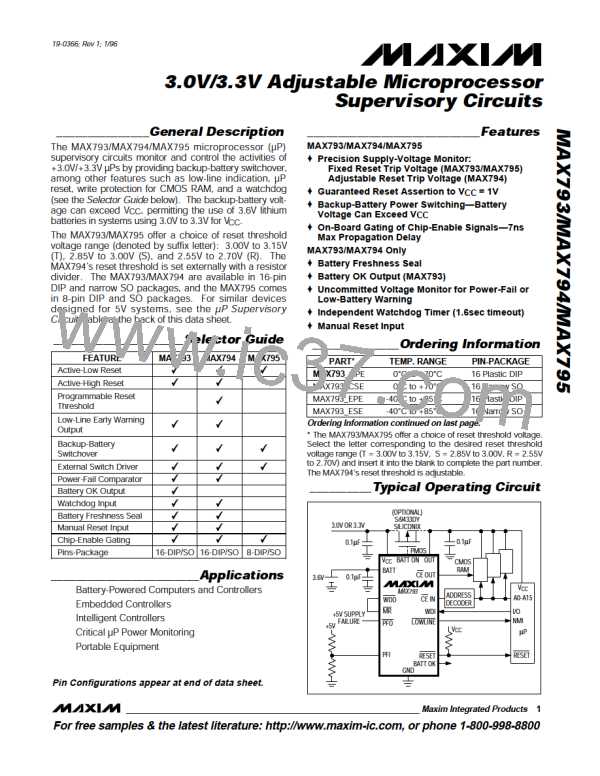3 .0 V/3 .3 V Ad ju s t a b le Mic ro p ro c e s s o r
S u p e rvis o ry Circ u it s
PFI. PFO can be used to generate an interrupt to the
µP or to cause reset to assert (Figure 12).
Ad d in g Hys t e re s is t o t h e P o w e r-Fa il
Co m p a ra t o r (MAX7 9 3 /MAX7 9 4 )
The power-fail comparator has a typical input hystere-
sis of 10mV. This is sufficient for most applications
where a power-supply line is being monitored through
an external voltage divider (see the section Monitoring
an Additional Power Supply).
In t e rfa c in g t o µP s w it h
Bid ire c t io n a l Re s e t P in s
Since the RESET output is open drain, the MAX793/
MAX794/MAX795 interface easily with µPs that have
bidirectional reset pins, such as the Motorola 68HC11.
Connecting the RESET output of the µP supervisor
directly to the RESET input of the microcontroller with a
single pull-up resistor allows either device to assert
reset (Figure 17).
If additional noise margin is desired, connect a resistor
between PFO and PFI as shown in Figure 16a. Select
the ratio of R1 and R2 such that PFI sees V
when
PFT
V
IN
falls to its trip point (V
). R3 adds the additional
TRIP
hysteresis and should typically be more than 10 times
the value of R1 or R2. The hysteresis window extends
Ne g a t ive -Go in g V
Tra n s ie n t s
CC
These supervisors are relatively immune to short-dura-
both above (V ) and below (V ) the original trip point
H
L
tion negative-going V transients (glitches) while issu-
CC
(V
TRIP
).
ing resets to the µP during power-up, power-down, and
brownout conditions. Therefore, resetting the µP when
Connecting an ordinary signal diode in series with R3,
as shown in Figure 16b, causes the lower trip point (V )
L
V
experiences only small glitches is usually not rec-
CC
to coincide with the trip point without hysteresis (V
),
TRIP
ommended.
so the entire hysteresis window occurs above V
.
TRIP
Figure 18 shows maximum transient duration vs. reset-
comparator overdrive, for which reset pulses are not
generated. The graph was produced using negative-
pulses, starting at 3.3V and ending below
the reset threshold by the magnitude indicated (reset
comparator overdrive). The graph shows the maximum
This method provides additional noise margin without
compromising the accuracy of the power-fail threshold
when the monitored voltage is falling. It is useful for
accurately detecting when a voltage falls past a thresh-
old. The current through R1 and R2 should be at least
1µA to ensure that the 25nA (max over temperature)
PFI input current does not shift the trip point. R3 should
be larger than 82kΩ so it does not load down the PFO
pin. Capacitor C1 is optional, and adds noise rejection.
going V
CC
34/MAX795
pulse width a negative-going V transient can typically
CC
Mo n it o rin g a n Ad d it io n a l P o w e r S u p p ly
These µP supervisors can monitor either positive or
negative supplies using a resistor voltage divider to
START
SET WDI
HIGH
100
90
80
70
60
50
40
30
PROGRAM
CODE
Subroutine or
Program Loop
SET WDI LOW
20
10
0
10 20 30 40 50 60 70 80 90 100
RETURN
RESET COMPARATOR OVERDRIVE, V - V (mV)
RST
CC
Figure 18. Maximum Transient Duration without Causing a
Reset Pulse vs. Reset Comparator Overdrive
Figure 19. Watchdog Flow Diagram
18 ______________________________________________________________________________________

 MAXIM [ MAXIM INTEGRATED PRODUCTS ]
MAXIM [ MAXIM INTEGRATED PRODUCTS ]